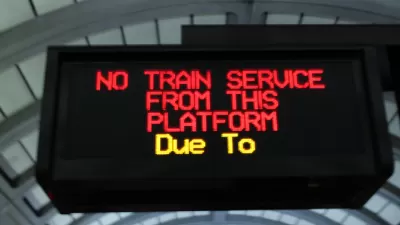TransitCenter's Steven Higashide argues that despite all the hype around self-driving vehicles, traditional high-capacity transit still has some distinct advantages. As long, that is, as transit agencies are willing to recognize them.

In a post adapted from remarks made by Steven Higashide, its director of research, TransitCenter outlines several things transit agencies should keep in mind as self-driving vehicles loom large in the public mind. "The threat that automated vehicles pose to public transit," he argues, "is a political threat."
Higashide's points include the following:
- High-capacity transit makes more efficient use of urban space than smaller vehicles, even when they're automated and/or shared.
- It'll be a while until automated vehicles can safely navigate busy urban cores and residential neighborhoods, even if they can be made functional on highways.
- Despite the high-tech veneer of public partnerships with transportation startups, "testing new technology for global motor vehicle markets for its own sake is a job for universities, research agencies, and private R&D."
- Transit systems need to become more competitive for current riders, and not simply hold out for potential tech-enabled solutions down the line.
FULL STORY: 4 Things For Transit Agencies to Remember in a World of Driverless Car Hype

Alabama: Trump Terminates Settlements for Black Communities Harmed By Raw Sewage
Trump deemed the landmark civil rights agreement “illegal DEI and environmental justice policy.”

Study: Maui’s Plan to Convert Vacation Rentals to Long-Term Housing Could Cause Nearly $1 Billion Economic Loss
The plan would reduce visitor accommodation by 25% resulting in 1,900 jobs lost.

Why Should We Subsidize Public Transportation?
Many public transit agencies face financial stress due to rising costs, declining fare revenue, and declining subsidies. Transit advocates must provide a strong business case for increasing public transit funding.

Paris Bike Boom Leads to Steep Drop in Air Pollution
The French city’s air quality has improved dramatically in the past 20 years, coinciding with a growth in cycling.

Why Housing Costs More to Build in California Than in Texas
Hard costs like labor and materials combined with ‘soft’ costs such as permitting make building in the San Francisco Bay Area almost three times as costly as in Texas cities.

San Diego County Sees a Rise in Urban Coyotes
San Diego County experiences a rise in urban coyotes, as sightings become prevalent throughout its urban neighbourhoods and surrounding areas.
Urban Design for Planners 1: Software Tools
This six-course series explores essential urban design concepts using open source software and equips planners with the tools they need to participate fully in the urban design process.
Planning for Universal Design
Learn the tools for implementing Universal Design in planning regulations.
Smith Gee Studio
Alamo Area Metropolitan Planning Organization
City of Santa Clarita
Institute for Housing and Urban Development Studies (IHS)
City of Grandview
Harvard GSD Executive Education
Toledo-Lucas County Plan Commissions
Salt Lake City
NYU Wagner Graduate School of Public Service





























